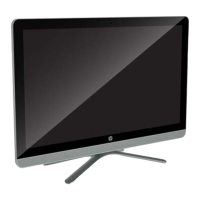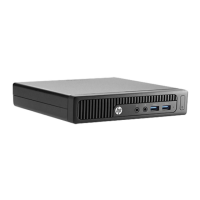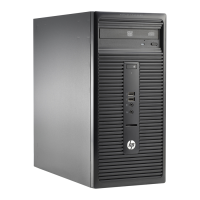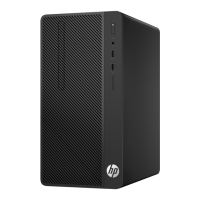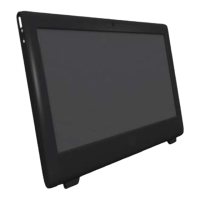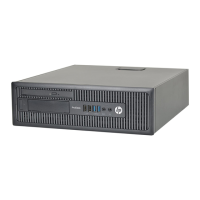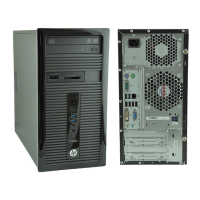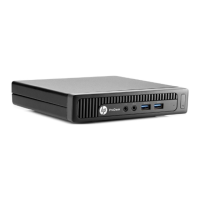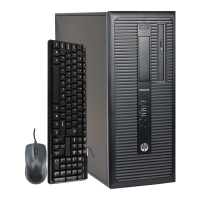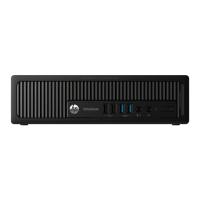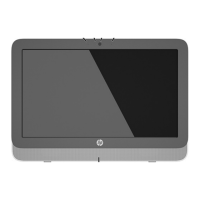
Do you have a question about the HP 205 G1 and is the answer not in the manual?
| Full HD | No |
|---|---|
| LED backlight | - |
| Display diagonal | 18.5 \ |
| Display resolution | 1366 x 768 pixels |
| Native aspect ratio | 16:9 |
| Processor cores | 2 |
| Processor model | E1-2500 |
| Processor family | AMD E |
| Processor frequency | 1.4 GHz |
| Processor manufacturer | AMD |
| Product type | All-in-One PC |
| Internal memory | 4 GB |
| Memory slots type | SO-DIMM |
| Memory clock speed | 1600 MHz |
| Internal memory type | DDR3-SDRAM |
| Maximum internal memory | 8 GB |
| Memory layout (slots x size) | 1 x 4 GB |
| HDD speed | 7200 RPM |
| HDD interface | SATA |
| Storage media | HDD |
| Optical drive type | DVD Super Multi |
| Card reader integrated | Yes |
| Total storage capacity | 500 GB |
| Storage drive interface | Serial ATA |
| Discrete graphics card model | Not available |
| On-board graphics card model | AMD Radeon HD 8240 |
| On-board graphics card family | AMD Radeon HD 8000 |
| Wi-Fi standards | Not supported |
| Ethernet LAN data rates | 10, 100 Mbit/s |
| Headphone outputs | 1 |
| USB 2.0 ports quantity | 4 |
| Thunderbolt ports quantity | 0 |
| Operating system installed | Ubuntu Linux |
| Product color | Black, Silver |
| Country of origin | China |
| Total megapixels | - MP |
| AC adapter power | 65 W |
| Operating temperature (T-T) | 5 - 35 °C |
| Operating relative humidity (H-H) | 15 - 80 % |
| Sustainability certificates | ENERGY STAR |
| Cables included | AC |
| Depth (with stand) | 72 mm |
|---|---|
| Width (with stand) | 470 mm |
| Height (with stand) | 329 mm |
| Weight (with stand) | 5500 g |
Details the user guide's scope and feature availability in different Windows editions.
Outlines the terms and conditions for using preinstalled software products.
Explains the meaning of WARNING, CAUTION, and NOTE text formatting in the manual.
Provides a general overview of the HP All-in-One Business PC features.
Identifies and illustrates the PC's front, top, right, left, and rear components.
Steps for activating and customizing software in Windows 10.
Steps for activating and customizing software in Windows 8.1.
Lists system boards and memory modules with associated part numbers.
Details hard drives and optical drives with their respective part numbers.
Lists various components like speakers, bezels, and stands with part numbers.
Lists essential cables used in the computer system and their part numbers.
Provides guidelines for SATA hard drives and their cables.
Explains the functionality of SMART ATA drives for failure prediction.
Information on preventing damage from static electricity during handling.
Methods and equipment for grounding and preventing static discharge.
Guidelines for operating the computer and general cleaning safety precautions.
Essential steps to safely prepare the computer for internal component removal.
Procedures for removing the rear cover and stand assembly.
Detailed instructions for replacing hard disk and optical disc drives.
Procedures for replacing webcam, converter board, power button board, and speakers.
Procedures for replacing memory modules and the WLAN module.
Procedures for replacing the RTC battery and the main system board.
Procedure for removing and replacing the computer's display panel.
Explains the F10 utility's capabilities and how to access it.
Details options within File, Storage, Security, Power, and Advanced menus.
Method for restoring computer configuration settings using the utility.
Guidelines for safe operation and steps before contacting technical support.
Addresses common issues like power, performance, general errors, and boot problems.
Solutions for problems related to hard drives, displays, audio, keyboard/mouse, and hardware installation.
Troubleshooting for network, internet access, optical drives, USB drives, and software problems.
Explains why and how to run HP PC Hardware Diagnostics.
Instructions for creating a bootable USB drive with the diagnostic tools.
Overview of creating recovery media, backups, and system restore points in Windows 10.
Details various system recovery options using HP Recovery or Windows tools.
Information on backup and recovery procedures specific to Windows 8.1.
Lists and explains POST errors with numeric codes and text messages.
Explains front panel LED patterns and audible signals for diagnosing POST errors.
How to set up and manage setup and power-on passwords.
Procedures for resetting passwords and clearing the computer's CMOS settings.
Outlines general and country-specific requirements for power cords.
Provides detailed technical specifications for the computer system.
